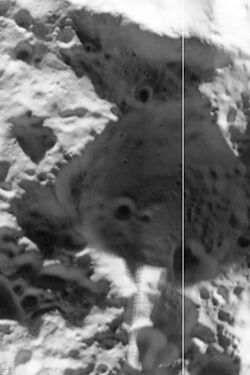Astronomy:Haworth (crater)
From HandWiki
Short description: Lunar surface depression
 | |
| Diameter | 51.4 km |
|---|---|
Haworth is an impact crater that lies at the south pole region of the Moon.[1] The crater is named after British chemist Walter Haworth.[2]
Formation
According to a 2015 study by Tye et al., Haworth was formed sometime during the Pre-Nectarian period, meaning it is at least 3.9 Ga (billion years) old.[3]
Physical features
Due to Haworth's position near the lunar south pole, large amounts of the crater are permanently shadowed regions. These regions are very cold; many are believed to never reach temperatures above 40 Kelvin, making Haworth colder than nearby craters such as Shackleton and Faustini.[4] Haworth and its surrounding low-lying areas are home to frost, which may be partly caused by these particularly low temperatures.[5]
See also
References
- ↑ "Chandrayaan-1 peeks inside Moon craters". Astronomy.com. January 16, 2009. http://www.astronomy.com/asy/default.aspx?c=a&id=7833. Retrieved June 22, 2010.
- ↑ "Two New Crater Names Approved for Earth's Moon". U.S. Geological Survey. October 30, 2008. https://astrogeology.usgs.gov/HotTopics/index.php?/archives/346-Two-New-Crater-Names-Approved-for-Earths-Moon.html. Retrieved June 22, 2010.
- ↑ Tye, Alexander R. (15 July 2015). "The age of lunar south circumpolar craters Haworth, Shoemaker, Faustini, and Shackleton: Implications for regional geology, surface processes, and volatile sequestration". Icarus (Elsevier) 255: 70–77. doi:10.1016/j.icarus.2015.03.016. Bibcode: 2015Icar..255...70T. https://www.sciencedirect.com/science/article/abs/pii/S0019103515001165. Retrieved September 2, 2022.
- ↑ Sefton-Nash, Elliott; Seigler, Matthew A.; Paige, David A. (2013). "Thermal Extremes in Permanently Shadowed Regions at the Lunar South Pole". Jet Propulsion Laboratory. NASA & UCLA. https://www.lpi.usra.edu/meetings/lpsc2013/eposter/2617.pdf. Retrieved September 2, 2022.
- ↑ Moores, John E. (16 December 2015). "Lunar water migration in the interval between large impacts: Heterogeneous delivery to Permanently Shadowed Regions, fractionation, and diffusive barriers". Journal of Geophysical Research: Planets (American Geophysical Union) 121 (1): 46–60. doi:10.1002/2015JE004929.
External links
 |

